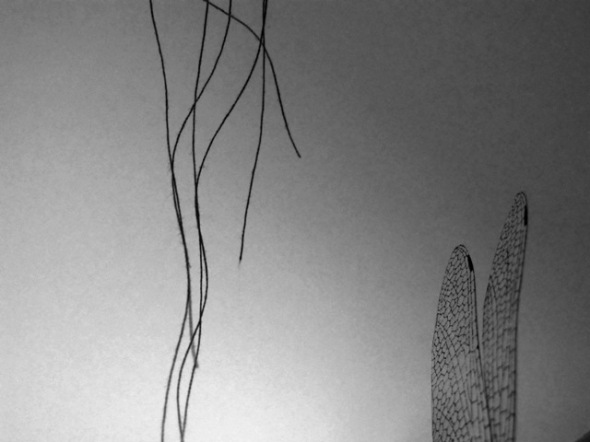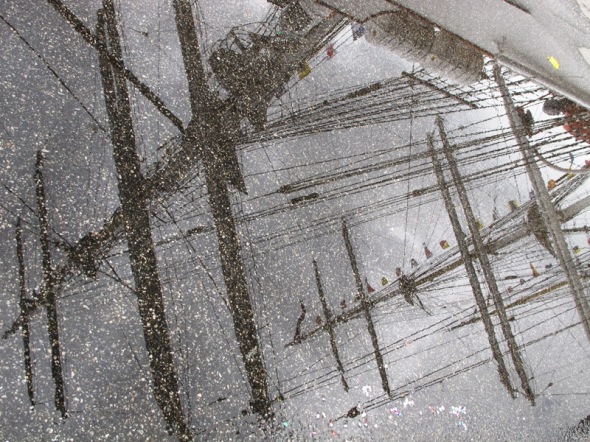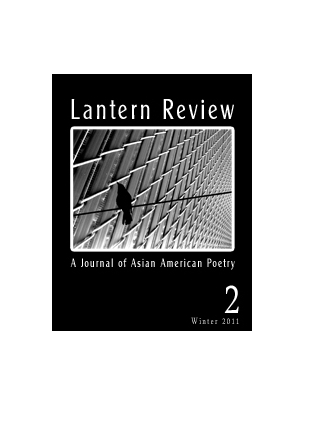Latest
In the Mood for Dhobi Ghat (A Review)
Kiran Rao’s film aptly called “Dhobi Ghat (Mumbai Dairies)” reveals itself in a series of personal documentations of a city that strides revolting opulence and abject poverty. Shai, an investment banker from NYC on a research sabbatical, is on a mission to discover Mumbai with the help of her very fancy photography equipment. She befriends Munna the dhobi for her family’s plush Mumbai home. Munna, an immigrant from Bihar, while trepidatiously falling in love with Shai, navigates her through the intestines of Mumbai: Nagpada, Mohammad Ali Road and of course the dhobi ghat. Shai’s black and white photographs are one set of diary entries about the city.
Shai also meets Arun, a tormented, reclusive painter who is also searching Mumbai for what makes sense as he puts the city and its people on canvas. He moves into an old ramshackle apartment on Mohammad Ali Road and finds a small box left behind by the previous tenant of the apartment. Among other things, the box contains a series of video letters by Yasmin Noor: an immigrant bride from Malihabad in Uttar Pradesh. Yasmin’s amateur videos about what she sees around her in this strange big city offer a counterpoint to Shai’s photographs and become another set of diary entries. The third set of documentation is by Arun who struggles to understand the space around him and reacts by retreating into himself. He finds a way out of himself and into the heart of his apartment and his city through Yasmin’s video letters. Like Munna shows Shai around, Yasmin becomes Arun’s guide. Arun begins to inhabit and paint Yasmin’s city and this is perhaps the most quietly reflecting, beautiful and moving part of the film.
It is hard to imagine the possibility of a meaningful encounter between a young burka clad bride from a small town in UP and an elite, reclusive artist in Mumbai but as Arun watches Yasmin’s videos and listens to her, he (and the audience) begin to connect to her deeply and intimately. The very spaces and people that were available to Arun all along: his apartment, the family that lives in the house across the street, the silent neighbor across the hall, the passionate Mumbai rains, all begin to resonate with significance once Yasmin mediates the experience for him. Arun synthesizes her experiences with his own and starts painting this new found sense of palpable absent presence. Art sublimates a social relationship that would otherwise seem quite impossible.
While the other characters are searching, explaining, mediating and documenting Mumbai, Munna lives in the city less self-consciously. As a result he is the most conscious of the city’s precariousness and is finally the most vulnerable to it. In his leaky shack by the train tracks, he builds his body, covers up for his friend who is mixed up with the gangs and he dreams of becoming an actor. He is the un-acknowledged connection between the Mumbai’s rich people. He is that which Shai is trying to understand and for whom Arun is painting tributes. While he is disarmingly present and obvious, he is also inscrutable. While the others are documenting the city; he embodies the city.
“Dhobi Ghat” is a beautifully told story that turns no cheap tricks. It is pretty much a slowly gathering mood film, like Wong Kar Wai’s “In the Mood for Love” (2000). The cinematography is stunning. The film is a visual treat. There is not a single song in the film but there is a haunting soundtrack by Gustavo Santaolalla with some parts that definitely sound like Ram Sampat’s contribution (he was in the acknowledgements). Kriti Malhotra’s debut as Yasmin Noor is certainly the heart and soul of the film. Kiran Rao’s direction even managed to keep Amir Khan restrained in his role. There is a subtle sense of humor just beneath the surface of the film and Prateik Babbar’s T-shirts are a big part of it. It took me a bit to warm up to Monica Dogra as Shai but she pulled it together before long. How Kittu Gidwani can continue to look so hot is a mystery, but I’ll live with it.
Roads

The Great Highway Squid System, New Jersey
This is an aerial image of the highway system close to Newark airport in central New Jersey. I took this on my recent flight to L.A to attend the MLA conference. That the early morning sun and the snow on the ground made everything look golden and silver at the same time is one thing, but how the roadway looks like a giant squid (with a jug handle) is quite another. It confirms my suspicion that roads are really tentacles and all the seemingly inanimate, inorganic objects that make up most of our civilization bound world are all oddly alive in a way that we will never really see or know. To figure out the sense of the one mortal life that each of us is charged with in relation to the other mortal lives around us seems overwhelming enough, to add the life of the inanimate to the list would seem all together too much. Yet, that is where literary-philosophical thought seems to be progressing.
Non-human lives and post-humanism seemed to underwrite a lot of the papers I heard at the MLA. The point there was not so much that we need to accord humanity to non-human things but that our version of the human is shaped by the inanimate, non-human, technologically animate things that we surround ourselves with. To understand ourselves we needn’t locate the center in us any longer, or start with ourselves any longer but look at the movements, affordances and appurtenances which occasion our humanity. The heliocentric universe was supposed to have dislocated the earth and its inhabitants from the false presumption of centrality in all things but the sun is too powerful a metaphor to not inhabit or give up to the margins. So the call is to decentralize, put power in the tips of the tentacles and all along its way, to know that the automotive-ants that crawl along it crawl with a kind of mechano-life that we would do well to acknowledge as our own.
Narrating Life

Freeway 405 L.A.
Yesterday, for a few minutes, I stood on an overpass above freeway 405 in L.A. Even through the wire safeguard it felt oddly thrilling to be standing in the face of high speed oncoming traffic. Cars whooshed by like dangerous electric fish in a loud dark river. Having been inside a car speeding up exactly this same freeway, going under this same overpass, I marveled at the perspectival differences of the two experiences. It is like being in the moment of its ordinary passing and then getting a chance to reflect on it in the context of a bigger picture. At each instance it is a different story, but each instance gives depth to the other. The imperceptible layering of perspectives, so that the narrative of one instance is richer for the sub-conscious knowledge of the other, is what makes even ordinary instances complex. So, briefly, yesterday evening I had a vantage view on passing life. It is not enough that I inhabit passing time, not if I want to narrate it too.
Two poems featured in Asia Writes
Ozu Bench and A Quiet Morning featured in Asia Writes on January 4th 2011
Over Tea and Cookies

“Are you not going to drink it?” She asked putting down her own dainty cup of tea in its equally dainty plate.
He stared into his cup of tea. The penumbra of the cup’s rim floated on the tea like a grey cuticle in a sea of skin. At that last thought he also put the cup down. An elegant porcelain tink confirmed that the tea cup was now on its plate and suddenly there was nothing more to do. For as long as he had held the cup in his hand – index finger crooked into its ear, thumb securing the grip – he was connected to the party. He was a part of the chatter; he looked the delighted guest. But now tea cup on the table, time was as empty as his hands. The chatter around him sloughed off like a shell. The sepia of play back set everything at an echoing distance. He sat alone in the center of a barren universe.
Raising the plate towards him, she said, “Try a lace cookie”. Half-coaxing, a quarter-annoyed and a quarter-pleading, her voice was just sharp enough to slice into him. He picked one from the picturesque heap. A whiff of cinnamon swirled into his brain. Reconnecting to his part, he held her eyes and said, “Thank you”.
Blue fringed world

Hope can sound so presumptuous, so loud, so jarring some times. Worst of all, though, is when hope rings false. Then there is such little to separate hope from dread. At other times, all there is to choose from is placebo hope and anodyne hope. The former, if it works, works like the latter and the latter is the only hope we have in this blue fringed world of sorrows.
Year End

Not nerve ends
but synapses.
Not pain passed
from the periphery
to the center but a
juncture. Busy body
neurons in ant hills.
Pathways made
rich with wandering.
Such wingtips
as grow from the
rigging to fill
rib cages with
falling, with flight.
Fabric

Scarves at Ten Thousand Villages
Yesterday’s snow walk through Highland Park was largely on the Main Street since the local businesses had made it a point to have the sidewalks shoveled. We walked into Ten Thousand Villages to ogle their collection of beautiful and unaffordable handicraft from around the world. I was admiring this set of scarves. The fabric looked warm and felt soft to the touch. To think that they are but warp and weft of proteins and fiber, but so is everything else.
Everything that is made up is fabric. In its earliest use the word fabric meant building or edifice. It also denoted the skill and contrivance to produce artifice. In a famous speech in The Tempest, Shakespeare’s Prospero’s likens the great globe itself to the baseless fabric of his vision that will dissolve, fade and leave not a rack behind. The baselessness of the fabric indicates Prospero’s moment of great despair in products of human endeavor that are ultimately insubstantial. This may have had a bigger etymological impact than we realize on the current day usage of fabric as verb. Now, the only context in which fabricating is used to indicate manufacture is lies. Lies, in essence, are insubstantial. In fact, Shakespeare hones in on exactly this sense of the usage in The Winter’s Tale when Camillo the counselor finds himself unable to shake the fabric of the king’s folly. As a jealous husband and a powerful king, Leontes’ fabric of folly is grand and held upright by a foundation of faith *. In this instance, Shakespeare brings together fabric as edifice with the fabrication of folly. That the notion of building and manufacturing should be etymologically and philosophically linked to the idea of folly is not so surprising; it is a reminder that all things manufactured are ultimately subject to time and decay. In this sense, folly is the foolishness of presumption or a matter of false faith. Prospero realizes this and Camillo finds that Leontes does not. In the modern usage fabrication is folly and severed from the idea of useful productivity. The industrial revolution took better care of allaying our misgivings about how much we can manufacture and how long we may presume for it to last.
While the verb has come to exclusively denote falsehood, the noun largely only refers to cloth or textile. This attribution of meaning dates back to the eighteenth century when textile turned the engine of industry along with iron founding. Cloth became the synecdoche for fabric and fabric has become the metaphor for life.
*
Swear his thought over
By each particular star in heaven and
By all their influences, you may as well
Forbid the sea for to obey the moon
As or by oath remove or counsel shake
The fabric of his folly, whose foundation
Is piled upon his faith and will continue
The standing of his body.
Reflection

I like to photograph reflections on tarred roads that have films of leftover rainwater. The gritty mosaic of a metalled road made slick with water is a good combination of texture and gloss that can articulate a surprising amount of detail. This road is by the Bergen harbor in Norway. The bare rigging of an anchored vessel caught gazing upon itself was like walking into the dressing room of an unprepared moment. Not wanting the moment to turn around and catch me looking, I stayed out of the reflection and waited, brooding on the reflection.
Reflections play with perspective, loosen the hold of what we know and lead us into uncertainty: to sink, flail or catch the first straw of certain knowledge and return to the harbor unchanged. Sometimes there is an unpredictable moment of insight, a momentary reprieve from the tyranny of what we already know and see. Then it is a moment of looking down on a tarred road and a puddle with a crest fallen half-a-yacht to find a broken piece of the night sky. I picked it up and brought it back with me.



